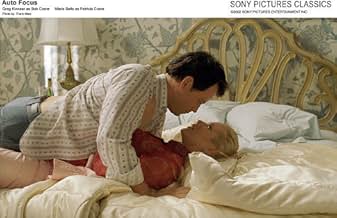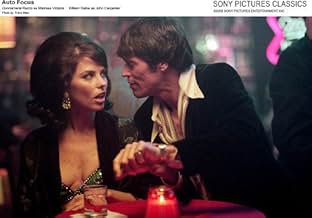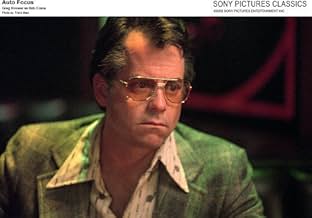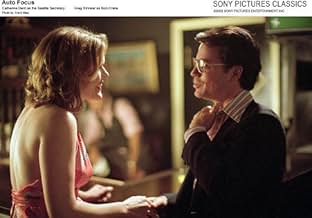A partir da história de vida movimentada e da morte misteriosa do ator Bob Crane (Greg Kinnear) o filme traça um retrato da identidade sexual masculina nos anos 1960 e 70.A partir da história de vida movimentada e da morte misteriosa do ator Bob Crane (Greg Kinnear) o filme traça um retrato da identidade sexual masculina nos anos 1960 e 70.A partir da história de vida movimentada e da morte misteriosa do ator Bob Crane (Greg Kinnear) o filme traça um retrato da identidade sexual masculina nos anos 1960 e 70.
- Direção
- Roteiristas
- Artistas
- Prêmios
- 6 indicações no total
- Richard Dawson
- (as Michael Rodgers)
- Melissa
- (as Donnamarie Recco)
- …
- Direção
- Roteiristas
- Elenco e equipe completos
- Produção, bilheteria e muito mais no IMDbPro
Avaliações em destaque
The film follows the sexual exploits of Greg Kinnear as Bob Crane, the real-life star of Hogan's Heroes, who during and after the show became a full-blown sex addict, ruining two marriages and possibly sabotaging his career in the process. Willem Dafoe is John Carpenter (no, I know what you're thinking, and he's not), Crane's partner in crime who lacks Crane's charisma with women but is fed some scraps by Crane in return for his extensive knowledge of and access to video equipment. Crane's fetish is using the home video cameras to record his sexual trysts, which he reviews over and over again, looking for something that we can't see, and that he probably can't see either.
Kinnear and Dafoe's performances alone are worth the price of admission. This is the best, boldest, and most nuanced work that Kinnear has ever done. His performance is all subtlety and detail; he introduces Crane as a regular, aw shucks family man, but as the movie progresses we gradually see the facade fall as his quiet desperation and insatiable sexual appetite begin to consume him. Not content to go over the top and yell at the top of his lungs to be effective, Kinnear instead puts on a fake smile and charms with a velvety voice while openly degrading and hitting on women. The effect is one of the most genuinely creepy performances ever committed to film. Dafoe is the perfect companion to Kinnear's subtle predator; Carpenter is a pathetic loser, easily angered and easily hurt. He gets angry, yells, and does all of the things that you've seen Dafoe do in his other portrayals of guys you wouldn't want to meet in a dark alley, or a lighted one, for that matter. It's effective elsewhere, and it's effective here. Together, these men form a pair so utterly joyless and shallow that just seeing them on-screen together made my stomach churn. Their dialogue is only incidental, usually reminiscing on previous sexual escapades or planning new ones, but it's the little tics, gestures, Kinnear's untouchable confidence foiled by Dafoe's insecurity, Kinnear's hidden hunger foiled by Dafoe's overt desperation, that give these scenes their resounding power.
Not to shortchange Schrader's direction, though, which as usual is right on target for the material. He begins in a brightly colored, idealized suburban landscape, filled with all of the usual imagery you'd expect in this sort of light-hearted period and location. Then, slowly, he slides into darker territory, carrying us into the decadent seventies, breaking shots into shorter lengths, shaking the camera, depicting with his cinematography and editing the fall of his protagonist. Admittedly, the techniques Schrader employs here to depict Crane's breakdown have been used many times before, but I still found them extremely effective here.
For the last thirty minutes of the film, I felt genuinely ill; not because I thought the projector was out of focus, as many have complained, but because Schrader and Kinnear were taking me to a dark place and immersing me in it. As I said before, this type of film is not for everybody, but for those interested in the dark side of man, this film is not to be missed. I think that at the very least, the merit of these depressing morality tales is that they provide an exact blueprint of the way not to live our lives. I suppose that showing Crane checking himself into therapy and dealing with his problems and utimately healing himself would be valuable as well, but it wouldn't make for a good film, or a true one. Some people argue against the very existence of this type of movie. My response to them is that in real life for every strong-willed person who solves their problems and triumphs over adversity, there is another loser who ultimately fails to deal with life and implodes upon their own insecurity and weakness. Until this changes, someone needs to continue making these films.
Director Paul Schrader often dives into the darker side of humanity. It's a sad portrait well delivered by Kinnear. On the other hand, the movie is not always great at delivering the danger and tension. For half of the movie, Bob Crane is not threatened with discovery. This keeps the tension low. It's got a chipper tone which is weird. It would have been nice to speed up the first half. It takes too long to get to his downfall. Willem Dafoe is equally strong and necessary for this movie to work. There is interesting work here but this should be more intense.
Greg Kinnear is definitely in one of his best parts here, as he plays someone who is an actor who keeps his actor-like charms off the set as well. In Hollywood, away from the confines of Connecticut, his Bob Crane lands the lead on Hogan's heroes, but can't resist the first temptations of the night-life. This comes, in an introductory way and then throughout as a tag-along/counterpart, with John Carpenter (not the director, played with the best match by Willem Dafoe of being a creep and alluring at times), who shows him the ropes and hooks him up with video equipment. But as Crane goes deeper into his sexual drives, divorces, marries again and divorces again, his acting career and his livelihood seem to slip away. The themes of being perversely the 'All-American Male' are accentuated by Kinnear's Crane in voice-over as he talks about the unbridled joys of sex, and in an interview with a Christian publication he says 'I don't...make waves'. By the last third of his story, however, into the rot of the 70s, he's lost touch with the reality of his pleasures- or rather necessities.
Auto Focus isn't at times an easy movie to sit through; it's even cringe-worthy in a couple of scenes (notably for me was when he guest stars on a celebrity cooking show, only to keep on his sexually-driven side with audience members). Then there are other scenes (i.e. 'you have fingers up you-know-where', and the genital enhancement) where male masculinity is questioned, and in very peculiar ways between Crane and Carpenter; Crane is homophobic, but then what exactly is Carpenter's function? More than anything, less than being a friend, he becomes a kind of unintentional pusher, where the draw of going out on the town becomes a crux for both of the men. What's just as fascinating then is how Schrader aligns this with his style- the first half is mostly very slick and professional-looking, almost like an HBO bio-pic or something. But then as the characters lose a grip on everything except themselves, there's a hand-held, distorted view to everything. There's lots of nudity and on-screen sex (some blurred out, likely by MPAA request), yet Schrader gets something more shocking, in the mind at least, as Carpenter almost becomes the antagonist in a way as the story winds down (the last phone call marks this most).
Auto Focus has the ideal of the usual biographical drama of a somebody in Hollywood who soon loses himself to becoming a nobody, but there's plenty under the surface that makes it more intriguing. Crane's two sides to his persona- the celebrity one, and the personal 'lifestyle' one- become one and the same after a while, Kinnear being able to make such a near-irredeemable person somewhat sympathetic (or at the least very watchable). And Carpenter's more truthful, emotional, and scary turn is made palatable by Dafoe's equally nuanced performance. It's not great, but it's a near-classic of the tale-of-such-and-such-star when so many don't take in what's deeper into account. A-
The movie hints very strongly that the killer was Bob Carpenter, played here by Willem Dafoe. Carpenter was a close friend of Crane's. Greg Kinnear does a credible job of portraying the television star.
However, the part about Crane's murder is only dealt with in the final minutes of the film! That was very disappointing and I was hoping to find out something or at least be given more information. They just kind tacked this on the end of the film.
Most of the film was about Crane's and Carpenter's escapades with women.....lots of women, beautiful and big-chested women, which you see in abundance in this film. Dafoe is the sleazy friend who introduces Crane to the beginning of the VCR age. That led to a whole bunch of sex-on-film and really whetted Crane's big sexual appetite.
Anyway, for people who watched "Hogan's Heroes," and there were plenty, this is a bio of him and perhaps, for those who know nothing about his death, who killed him.
Greg Kinnear taps into Bob Crane, though, from the first frame.
The viewer learns that the pre-Hogan Crane was an affable, lovable kind of guy whose LA radio show had a big following. His agent sees him as a combination of Jack Lemmon and Jack Benny, a potential star of fluffy sex comedies with a benign sort of sex appeal and a knack for snappy one-liners All of that was a vast overestimation of Crane's talents.
Crane reveled in the fame that "Hogan" brought him, but he seems never to have taken a long view of his career. When the show ended he was left rudderless and idle, having slowly cut the ties that bound him to ordinary life -- his work, a stable home life, and his religious faith.
While he coasted, Crane took advantage of the easy, cynical charm he conveyed on screen to lure women. By the dozen. I think he probably enjoyed being the least likely man in Hollywood to skulk strip clubs looking for prey, and to devote thousands of yards of videotape to his exploits with them. But his naivete is telling: Crane allows himself to be led into a netherworld by John Carpenter, (Willem Dafoe), who teaches him that putting sex on film is more fun than having it. And there is a brief scene where Crane meets a dominatrix and reveals himself as not quite savvy enough to play this game to win.
Addictions tend to claim those who are on the way up or the way down. Even before Peg Entwistle famously jumped off the Hollywoodland sign in 1922, there have been scores of aspirants to fame or has-beens whose compulsions have killed them, leaving their work on screen the least compelling,least-remembered part of their lives.
Você sabia?
- CuriosidadesThe leather jacket that Greg Kinnear wears while playing Bob Crane in the Guerra, Sombra e Água Fresca (1965) scenes of this movie is the one that the real Crane actually wore during the filming of that TV series. Crane's son Robert David Crane loaned the jacket to Kinnear for this movie. Prior to the original "Hogan's Heroes" show, Frank Sinatra wore this exact same jacket in O Expresso de Von Ryan (1965).
- Erros de gravaçãoThere is a glimpse of the famous Capitol Records building painted silver. At the time of the film, it was actually painted black to resemble a stack of records.
- Citações
Bob Crane: I think it's perfect for me. I mean, this character Hogan, he's quick on his toes, he's hip, he's a con artist. I don't wanna jinx it, but I think it's what I've been working toward my whole career!
Anne Crane: Really? You've been working towards a Holocaust comedy?
Bob Crane: Ann!
Anne Crane: What, Bob?
Bob Crane: Please, not in front of the children! They look up to me!
Anne Crane: They're small. They look up to everyone.
- Versões alternativasThe following deleted scenes appear on the DVD:
- Victoria finds Bob's body.
- Hogan's Heroes Montage
- Bob unloads drums and some dirty magazines fall out.
- Anne and Bob talking by the pool.
- Anne in the darkroom.
- ConexõesFeatured in Auto Focus: Featurette (2002)
- Trilhas sonorasSnap!
Written by Paul Schrader and Angelo Badalamenti
Performed by David Johansen (as Buster Poindexter)
Produced by Brian Koonin
Principais escolhas
- How long is Auto Focus?Fornecido pela Alexa
Detalhes
- Data de lançamento
- País de origem
- Central de atendimento oficial
- Idioma
- Também conhecido como
- Autofocus
- Locações de filme
- Empresas de produção
- Consulte mais créditos da empresa na IMDbPro
Bilheteria
- Orçamento
- US$ 7.000.000 (estimativa)
- Faturamento bruto nos EUA e Canadá
- US$ 2.063.196
- Fim de semana de estreia nos EUA e Canadá
- US$ 123.761
- 20 de out. de 2002
- Faturamento bruto mundial
- US$ 2.704.951
- Tempo de duração1 hora 45 minutos
- Cor
- Mixagem de som
- Proporção
- 1.85 : 1
Contribua para esta página










































